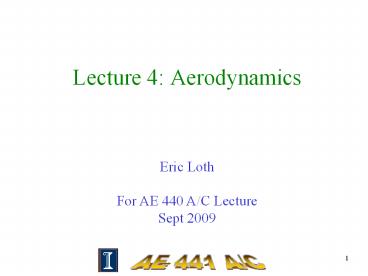Lecture%204:%20Aerodynamics PowerPoint PPT Presentation
Title: Lecture%204:%20Aerodynamics
1
Lecture 4 Aerodynamics
Eric Loth For AE 440 A/C Lecture Sept 2009
2
Suggested Aerodynamics Responsibilities
- Aerodynamic design including external
configuration of airfoil, wing geometry and
fuselage for cruise, take-off and landing
configurations (to configuration person) - Component and total system lift-and-drag
coefficient relationships for wing and aircraft
(develop drag polars) - Develop model for lift drag for cruise,
take-off and landing (to performance person) - Select optimum airfoil and provide spanwise and
even chord-wise wing-loads (to structures person) - Wing lift-and-moment coefficients (to stability
and control person) - Employ CFD Analysis to check and optimize airfoil
performance at Reynolds number - Based on historical review, trade studies, and
logic decisions and other aspects of aircraft
thus will continually evolve throughout semester
3
Wing Design
- Important considerations/constraints
- Performance (cruise, loiter, take-off, landing)
- Flying qualities (handling and stability)
- Structural considerations (spar placement)
- Internal volume (for fuel/payload)
- Stealth characteristics (for military subsonic)
- Airport limitations (wing-span)
4
Wing Layout
- Aspect ratio
- Airfoil selection
- Wing location
- Sweep
- Taper ratio
- Twist (aerodynamic and geometric)
- Dihedral
Geometric characteristics of the wing planform
(Jenkinson).
5
Airfoil Design
- Designed primarily for best cruise and/or loiter
for given aircraft/wing configuration (and Mach
and Reynolds number) - Maximum section lift coefficient is also
important but will be a function of flaps for
landing and take-off - Designed to have robustness (to icing, roughness,
damage, etc.) depending on vehicle utility - Many airfoils have tabled properties from wind
tunnel data (XFOIL not as accurate but allows
custom design) - May include laminar flow design for cruise
performance (and active flow control for high
angle performance)
6
Estimation of CL,max
- Wing CL,max is always less than the section
maximum value. - An initial approximation of CL,max for a swept
wing is
7
Effective Lift-Curve Slope
- Helmbolt equation
Comparison of a NACA 65-210 airfoil lift curve
with that of a wing using the same airfoil
(McCormick).
8
Effect of High-Lift Devices
Effect of leading edge devices on lift
curve (Jenkinson).
9
Estimation of DCL,max due to flaps
Definition of flapped wing area
(Roskam).
10
Drag Estimation
- Profile drag
- Fuselage
- Wing
- Tail Surfaces
- Engine Nacelles
- Landing gear
- Flaps
11
Drag Components
- Pressure drag
- Inviscid component often proportional to
frontal area - Form drag
- Viscous component often proportional to wetted
area - Induced drag
- Inviscid component due to lift distribution
- Interference drag
- Due to components in proximity to each other
- Wave drag
- Present when flying at high Mach numbers
- See Raymer, Roskam, McCormick, etc., on
estimating each of the drag components
12
Component Drag Build-up
- Build-up of parasite drag based on a common area,
e.g. wing area (Swing) - Drag Coefficient for individual aircraft
components (CD,i) may be summed using the
relevant component area (Swing) which can be a
wetted area, frontal area, etc.
13
Load Distribution
- Start with assuming elliptic distribution
- Refine w/ Schrenks approx., lifting-line or
advanced analysis - Design (twist) to avoid stall near outboard
control surfaces
14
Tail Design
- Tail sized and positioned length-wise by
Stability and Control Person - Lift and Drag of tail taken into account by
Aerodynamics Person (using methods similar to
wing) - Both select vertical placement to minimize
interference from wing wake/engine wash
15
Induced Effects
- Geometric tail incidence based on required moment
and downwash
Approximate model for calculating downwash
angle (McCormick).
16
Pre-calculated Charts
Downwash angle as a function of the distance of
the tail behind and above The wing (McCormick).
17
Effect of sweep back on downwash angle
(McCormick).
18
Samples of Aerodynamic Analysis from Previous AE
440 Reports
19
Aircraft Lift Coefficient
20
Airfoil Design and Performance
21
Lift Distribution
22
Aero Performance and Trades
- LWT Low-Wing Tractor
- HWTHigh-Wing Tractor
- LWPLow-Wing Pusher
Mission Segment Performance Polars (for
configurations person)
23
Aero Performance

